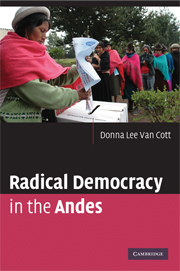Book contents
- Frontmatter
- Contents
- Acknowledgments
- List of Acronyms
- 1 Introduction: The Political and Cultural Origins of Democratic Institutional Innovation
- 2 The Legal and Political Context for Municipal Reform in Bolivia and Ecuador
- 3 Mayoral Leadership and Democratic Institutional Innovation
- 4 Political Parties, Civil Society, and Democratic Institutional Innovation
- 5 Institutional Innovation in Ecuador
- 6 Institutional Innovation in Bolivia
- 7 Conclusion: An Interaction Model of Democratic Institutional Innovation
- References
- Index
4 - Political Parties, Civil Society, and Democratic Institutional Innovation
Published online by Cambridge University Press: 05 September 2012
- Frontmatter
- Contents
- Acknowledgments
- List of Acronyms
- 1 Introduction: The Political and Cultural Origins of Democratic Institutional Innovation
- 2 The Legal and Political Context for Municipal Reform in Bolivia and Ecuador
- 3 Mayoral Leadership and Democratic Institutional Innovation
- 4 Political Parties, Civil Society, and Democratic Institutional Innovation
- 5 Institutional Innovation in Ecuador
- 6 Institutional Innovation in Bolivia
- 7 Conclusion: An Interaction Model of Democratic Institutional Innovation
- References
- Index
Summary
The opportunity to operate as a social movement in the streets, outside the political system, while also holding elected office, maximizes the leverage that indigenous social movements can bring to bear against opponents. When such movements represent excluded groups, their participation in government improves the quality of local democracy by improving representation and strengthening its legitimacy. But expanding fields of contention into formal institutions carries risks. Powerful elites design institutions to control dissent and exclude challengers. Having surmounted these obstacles to inclusion, entering formal institutions subjects social-movement representatives to the same pressures and incentives that their predecessors faced. The result may be a change of faces in government but not necessarily an improvement in democratic quality.
The ambivalence of indigenous movements with respect to formal and informal politics is reflected in a well-known statement that MIP leader Felipe Quispe made after his election to Congress in 2002. He vowed that while he played with one hand the game of democracy, with the other he would hide a stone under his poncho (La Prensa 2002: 8). How can social-movement activists entering new democratic institutions be persuaded to put down their stones? How can they do so without betraying the principles of the social movements that launched their political careers and, consequently, losing support?
- Type
- Chapter
- Information
- Radical Democracy in the Andes , pp. 95 - 133Publisher: Cambridge University PressPrint publication year: 2008

